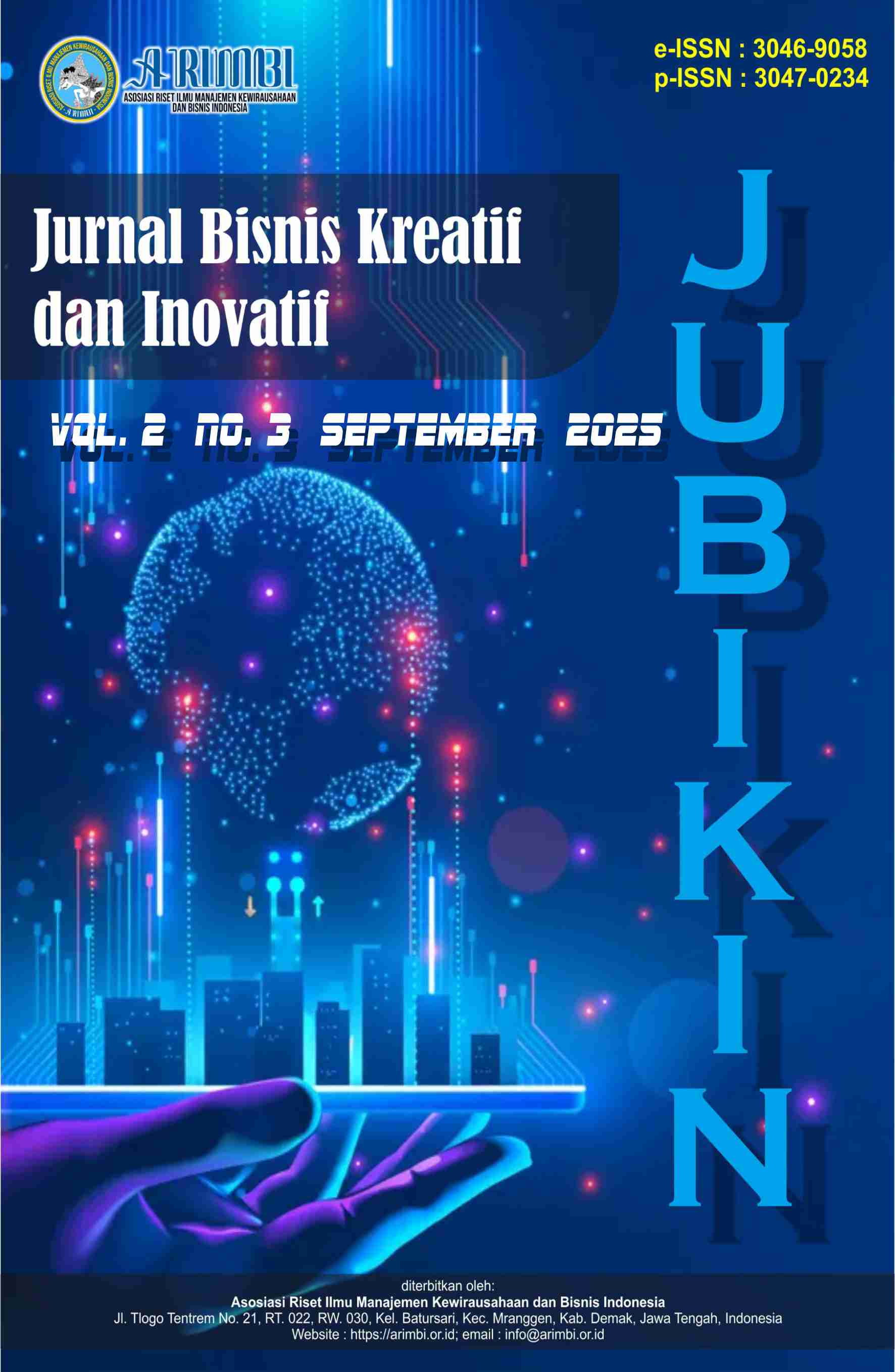Analisis Du Pont System untuk Menilai Kinerja Keuangan PT ABC, Tbk Periode 2019-2023
DOI:
https://doi.org/10.61132/jubikin.v2i3.761Keywords:
2019–2023 period, Du Pont System, Financial Performance, Financial Ratio, PT ABCAbstract
This study aims to analyze the financial performance of PT ABC Tbk during the period 2019–2023 using the Du Pont System as the primary analytical tool. The Du Pont System is widely recognized as a comprehensive method to evaluate a company’s overall performance by breaking down profitability into several key components: net profit margin, total asset turnover, return on investment (ROI), equity multiplier, and return on equity (ROE). The research employs a descriptive quantitative approach, with data sourced from secondary materials in the form of official financial statements published by the Indonesia Stock Exchange (IDX). A purposive sampling technique was applied to ensure the relevance and accuracy of the data analyzed. The findings reveal that the company’s financial performance throughout the five-year observation period has been less than optimal. Each of the main components of the Du Pont System showed average ratios that fell below the industry benchmark, indicating structural weaknesses in both profitability and efficiency. Specifically, the net profit margin and total asset turnover were constrained by high operational costs, while ROI and ROE were further pressured by volatility in foreign exchange rates. These inefficiencies highlight the vulnerability of the company’s financial structure to both internal management challenges and external macroeconomic factors. Based on the results, the study provides several strategic recommendations to improve financial performance. First, optimization of cost management is necessary to reduce operational inefficiencies that directly affect profit margins. Second, the implementation of foreign exchange risk mitigation strategies, such as hedging, is suggested to minimize the negative impacts of currency fluctuations. Finally, to strengthen revenue growth, the company is encouraged to adopt and expand digital marketing initiatives as a means of improving sales performance and market penetration. Overall, this study emphasizes the importance of integrating financial control with strategic innovation to ensure long-term sustainability and competitiveness in the pharmaceutical industry.
Downloads
References
Amruddin, A., dkk. (2022). Metodologi penelitian kuantitatif. Pradina Pustaka.
Bangun, A. A. (2023). Analisis kinerja keuangan menggunakan Du Pont System pada PT Adhi Karya (Persero) Tbk periode 2017-2021. Jurnal Riset Ilmu Manajemen, 1(4), 429-443. https://doi.org/10.61132/rimba.v1i4.617
Hery. (2016). Analisis laporan keuangan (Edisi digital). PT Gramedia. https://doi.org/10.58217/jubisma.v4i1.63
Inayah, Z. (2022). Analisis struktur modal, profitabilitas dan kinerja keuangan terhadap nilai perusahaan (penelitian literature review manajemen keuangan). Jurnal Manajemen Pendidikan dan Ilmu Sosial, 3(2), 788-795. https://doi.org/10.38035/jmpis.v3i2
Karlinda, B., & Ratnasari, I. (2021). Analisis Du Pont System untuk mengukur kinerja keuangan perusahaan. Journal of Economics and Business, 17(4), 626-635. https://doi.org/10.30872/jinv.v17i4.10350
Kurniasari, D., & Santoso, B. H. (2023). Analisis Du Pont System dan Altman Z-Score dalam mengukur kinerja keuangan perusahaan manufaktur subsektor XY di BEI. Jurnal Ilmu dan Riset Manajemen, 12(4), 1-14.
Oktaviani, A. V., dkk. (2022). Analisis kinerja keuangan menggunakan Du Pont System pada PT Mandom Indonesia Tbk. Jurnal Economix, 10(2), 210-220.
Ovami, D. C. (2021). Pasar modal di era revolusi investasi 4.0. UMSU Press.
Prasetiyo, O. F., & Isnuwardiati, K. (2022). Perbandingan kinerja keuangan perusahaan manufaktur dengan metode Du Pont saat pra dan saat pandemi Covid-19. Jurnal Manajemen Sumber Daya Manusia, Administrasi dan Pelayanan Publik, 9(2), 220-230. https://doi.org/10.37606/publik.v9i2.335
Rabbani, R. A., dkk. (2023). Analisis kinerja keuangan PT Kereta Api Indonesia (Persero) dengan metode Du Pont System. Jurnal Implementasi Manajemen & Kewirausahaan, 3(1), 59-75. https://doi.org/10.38156/imka.v3i1.173
Rahmawati, T. I. (2024). Analisis Du Pont untuk mengukur kinerja keuangan pada industri media dan hiburan yang terdaftar di BEI tahun 2017-2021. Jurnal Eco-Fin, 6(1), 1-10. https://jurnal.kdi.or.id/index.php/ef https://doi.org/10.32877/ef.v6i1.860
Riyanto, S., & Setyorini, W. (2024). Metode penelitian kuantitatif dengan pendekatan SmartPLS 4.0. CV Budi Utama.
Ronal, M. (2023). Analisis laporan keuangan dengan Du Pont System sebagai dasar untuk mengukur kinerja keuangan (studi kasus pada UD. Karya Cipta Mandiri). Jurnal Riset Manajemen dan Ekonomi, 1(1), 242-261. https://doi.org/10.54066/jrime-itb.v1i1.192
Saputri, N., dkk. (2022). Analisis kinerja keuangan perusahaan dengan menggunakan Du Pont System. Jurnal Ekonomi, Manajemen dan Akuntansi, 24(2), 355-362. https://doi.org/10.29264/jfor.v24i2.10608
Siahaan, L. H., dkk. (2025). Analisis data penelitian. Penerbit Karya Bakti Makmur (KBM) Indonesia.
Sudiyono, R. N., dkk. (2022). Analisis kinerja keuangan dengan menggunakan metode Du Pont System. Jurnal Jubisma, 4(1), 32-39.
Sugiyono. (2015). Metode penelitian kuantitatif, kualitatif, dan R&D. Alfabeta.
Sugiyono. (2019). Metode penelitian kuantitatif, kualitatif, dan R&D. Alfabeta.
Yusuf, M. (2017). Metode penelitian: Kuantitatif, kualitatif, dan penelitian gabungan. Kencana.
Zahra, A. A., & Febrianty. (2022). Analisis Du Pont System dalam menilai kinerja keuangan pada sektor makanan dan minuman di BEI periode 2016-2020. Riset & Jurnal Akuntansi, 7(3), 3217-3226. https://doi.org/10.33395/owner.v6i3.923
Downloads
Published
How to Cite
Issue
Section
License
Copyright (c) 2025 Jurnal Bisnis Kreatif dan Inovatif

This work is licensed under a Creative Commons Attribution-ShareAlike 4.0 International License.





